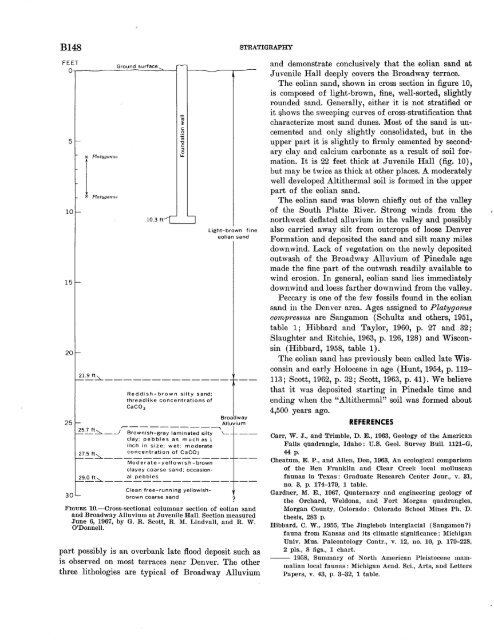RESEARCH· ·1970·
RESEARCH· ·1970·
RESEARCH· ·1970·
Create successful ePaper yourself
Turn your PDF publications into a flip-book with our unique Google optimized e-Paper software.
B148<br />
5<br />
10<br />
15<br />
20<br />
X<br />
X<br />
Plntygonus<br />
Pla.tygon'll.~<br />
10.3 ft<br />
iii<br />
~<br />
c<br />
0<br />
:;;<br />
Cll<br />
"tl<br />
c<br />
:J<br />
0<br />
u..<br />
2l~ftl ____________ _<br />
Reddish-brown silty sand;<br />
threadlike concentrations of<br />
CaC0 3<br />
Light-brown fine<br />
eolian sand<br />
Broadway<br />
25 Alluvium<br />
25.7 ft ,------:-----:-----:-----<br />
_:::::::,._ _ _; Brown1sh-gray laminated s1lty '-<br />
clay; pebbles as much as 1<br />
inch in size; wet; moderate<br />
27~~--~~~rati~~CaCOJ ___<br />
30<br />
Moderate- yellowish- brown<br />
clayey coarse sand; occasion-<br />
29~~--~~bbl:.:._ ______ _<br />
Clean free-running yellowishbrown<br />
coarse sand<br />
FIGURE 10.-Cross-sectional columnar section of eolian sand<br />
and Broadway Alluvium at Juvenile Hall. Section measured<br />
June 6, 1967, by G. R. Scott, R. l\1. Lindvall, .and R. W.<br />
O'Donnell.<br />
part possibly is an overbank late flood deposit such as<br />
is observed on most terraces near Denver. The other<br />
three lithologies are typical of Broadway Alluvium<br />
?<br />
STRATIGRAPHY<br />
and demonstrate conclusively that the eolian sand at<br />
Juvenile Hall deeply covers the Broadway terrace.<br />
The eolian sand, shown in cross section in figure 10,<br />
is composed of light-brown, fine, well-sorted, slightly<br />
rounded sand. Generally, either it is not stratified or<br />
it ~hows the sweeping curves of cross-stratification that<br />
characterize most sand dunes. Most of the sand is uncemented<br />
and only slightly consolidated, but in the<br />
upper part it is slightly to firmly cemented by secondary<br />
clay and calcium carbonate as a result of soil formation.<br />
It is 22 feet thick at Juvenile Hall (fig. 10),<br />
but may be twice as thick at other places. A moderately<br />
well developed Altithermal soil is formed in the upper<br />
part of the eolian sand.<br />
The eolian sand was blown chiefly out of the valley<br />
of the South Platte River. Strong winds from the<br />
northwest deflated alluvium in the valley and possibly<br />
also carried away silt from outcrops of loose Denver<br />
Formation and deposited the sand and silt many miles<br />
down wind. Lack of vegetation on the newly deposited<br />
outwash of the Broadway Alluvium of Pinedale age<br />
made the fine part of the outwash readily available to<br />
wind erosion. In general, eolian sand lies immediately<br />
downwind and loess farther downwind from the valley.<br />
Peccary is one of the few fossils found in the eolian<br />
sand in the. Denver area. Ages assigned to Platygonus<br />
compresstts are Sangamon (Schultz and others, 1951,<br />
table 1; Hibbard and Taylor, 1960, p. 27 and 32;<br />
Slaughter and Ritchie, 1963, p. 126, 128) and Wisconsin<br />
(Hibbard, 1958, table 1).<br />
The eolian sand has previously been called late Wisconsin<br />
and early Holocene in age (Hunt, 1954, p. 112-<br />
113; Scott, 1962, p. 32; Scott, 1963, p. 41). We believe<br />
that it was deposited starting in Pinedale time and<br />
ending when the "Altithermal" soil was formed about<br />
4,500 years ago.<br />
REFERENCES<br />
Carr, W. J., and Trimble, D. E., 1963, Geology of the American<br />
Falls quadrangle, Idaho: U.S. Geol. Survey Bull. 1121-G,<br />
44 p.<br />
Cheatum, E. P., and Allen, Don, 1963, An ecological comparison<br />
of the Ben Franklin and Clear Creek local molluscan<br />
faunas in Texas: Graduate Research Center Jour., v. 31,<br />
no. 3, p. 174-179, 1 table.<br />
Gardner, M. E., 1967, Quaternary and engineering geology of<br />
the Orchard, Weldona, and Fort Morgan quadrangles,<br />
Morgan County, Colorado: Colorado School Mines Ph. D.<br />
thesis, 283 p.<br />
Hibbard, C. W., 1955, The Jinglebob interglacial ( Sangamon?)<br />
fauna from Kansas and its climatic significance: Michigan<br />
Univ. Mus. Paleontology Contr., v. 12, no. 10, p. 170-228,<br />
2 pls., 8 figs., 1 chart.<br />
-- 1958, Summary of North American Pleistocene mammalian<br />
local faunas: Michigan Acad. Sci., Arts, and Letters<br />
Papers, v. 43, p. 3-32, 1 table.
















